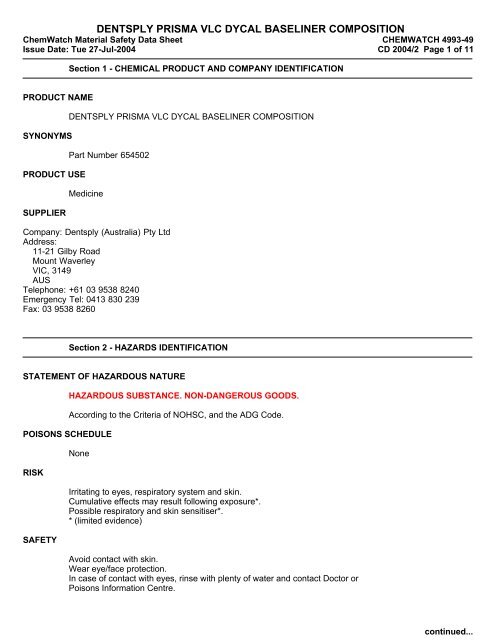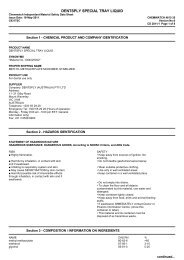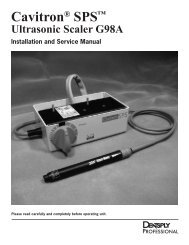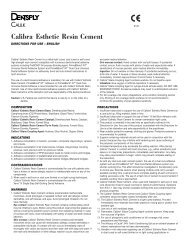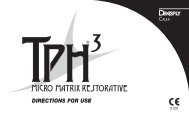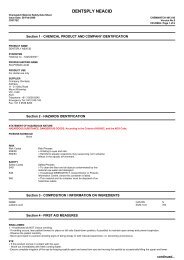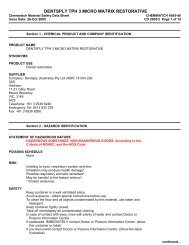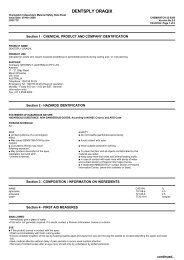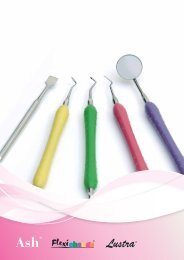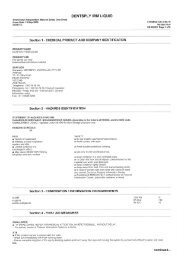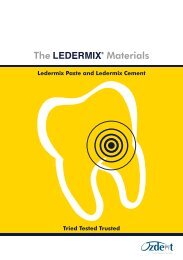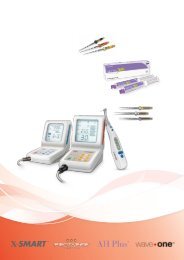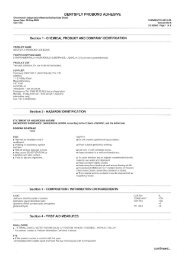ChemWatch MSDS 4993-49 - Dentsply
ChemWatch MSDS 4993-49 - Dentsply
ChemWatch MSDS 4993-49 - Dentsply
You also want an ePaper? Increase the reach of your titles
YUMPU automatically turns print PDFs into web optimized ePapers that Google loves.
DENTSPLY PRISMA VLC DYCAL BASELINER COMPOSITION<br />
<strong>ChemWatch</strong> Material Safety Data Sheet CHEMWATCH <strong><strong>49</strong>93</strong>-<strong>49</strong><br />
Issue Date: Tue 27-Jul-2004 CD 2004/2 Page 1 of 11<br />
Section 1 - CHEMICAL PRODUCT AND COMPANY IDENTIFICATION<br />
PRODUCT NAME<br />
SYNONYMS<br />
PRODUCT USE<br />
SUPPLIER<br />
DENTSPLY PRISMA VLC DYCAL BASELINER COMPOSITION<br />
Part Number 654502<br />
Medicine<br />
Company: <strong>Dentsply</strong> (Australia) Pty Ltd<br />
Address:<br />
11-21 Gilby Road<br />
Mount Waverley<br />
VIC, 31<strong>49</strong><br />
AUS<br />
Telephone: +61 03 9538 8240<br />
Emergency Tel: 0413 830 239<br />
Fax: 03 9538 8260<br />
Section 2 - HAZARDS IDENTIFICATION<br />
STATEMENT OF HAZARDOUS NATURE<br />
POISONS SCHEDULE<br />
RISK<br />
SAFETY<br />
HAZARDOUS SUBSTANCE. NON-DANGEROUS GOODS.<br />
According to the Criteria of NOHSC, and the ADG Code.<br />
None<br />
Irritating to eyes, respiratory system and skin.<br />
Cumulative effects may result following exposure*.<br />
Possible respiratory and skin sensitiser*.<br />
* (limited evidence)<br />
Avoid contact with skin.<br />
Wear eye/face protection.<br />
In case of contact with eyes, rinse with plenty of water and contact Doctor or<br />
Poisons Information Centre.<br />
continued...
DENTSPLY PRISMA VLC DYCAL BASELINER COMPOSITION<br />
<strong>ChemWatch</strong> Material Safety Data Sheet CHEMWATCH <strong><strong>49</strong>93</strong>-<strong>49</strong><br />
Issue Date: Tue 27-Jul-2004 CD 2004/2 Page 2 of 11<br />
Section 3 - COMPOSITION / INFORMATION ON INGREDIENTS<br />
NAME CAS RN %<br />
urethane dimethacrylate resin 55-60<br />
calcium hydroxide 1305-62-0
DENTSPLY PRISMA VLC DYCAL BASELINER COMPOSITION<br />
<strong>ChemWatch</strong> Material Safety Data Sheet CHEMWATCH <strong><strong>49</strong>93</strong>-<strong>49</strong><br />
Issue Date: Tue 27-Jul-2004 CD 2004/2 Page 3 of 11<br />
Section 4 - FIRST AID MEASURES ...<br />
cricothyroidotomy or tracheotomy may be necessary.<br />
· Oxygen is given as indicated.<br />
· The presence of shock suggests perforation and mandates an intravenous line<br />
and fluid administration.<br />
· Damage due to alkaline corrosives occurs by liquefaction necrosis whereby the<br />
saponification of fats and solubilisation of proteins allow deep penetration<br />
into the tissue.<br />
Alkalis continue to cause damage after exposure.<br />
INGESTION:<br />
· Milk and water are the preferred diluents<br />
No more than 2 glasses of water should be given to an adult.<br />
· Neutralising agents should never be given since exothermic heat reaction may<br />
compound injury.<br />
* Catharsis and emesis are absolutely contra-indicated.<br />
* Activated charcoal does not absorb alkali.<br />
* Gastric lavage should not be used.<br />
Supportive care involves the following:<br />
· Withhold oral feedings initially.<br />
· If endoscopy confirms transmucosal injury start steroids only within the first<br />
48 hours.<br />
· Carefully evaluate the amount of tissue necrosis before assessing the need for<br />
surgical intervention.<br />
· Patients should be instructed to seek medical attention whenever they develop<br />
difficulty in swallowing (dysphagia).<br />
SKIN AND EYE:<br />
· Injury should be irrigated for 20-30 minutes.<br />
Eye injuries require saline. [Ellenhorn & Barceloux: Medical Toxicology]<br />
Section 5 - FIRE FIGHTING MEASURES<br />
EXTINGUISHING MEDIA<br />
· Water spray or fog.<br />
· Foam.<br />
· Dry chemical powder.<br />
· BCF (where regulations permit).<br />
· Carbon dioxide.<br />
FIRE FIGHTING<br />
· Alert Fire Brigade and tell them location and nature of hazard.<br />
· Wear full body protective clothing with breathing apparatus.<br />
· Consider evacuation (or protect in place).<br />
· Use water delivered as a fine spray to control fire and cool adjacent area.<br />
· DO NOT approach containers suspected to be hot.<br />
· Cool fire exposed containers with water spray from a protected location.<br />
· If safe to do so, remove containers from path of fire.<br />
· Equipment should be thoroughly decontaminated after use.<br />
continued...
DENTSPLY PRISMA VLC DYCAL BASELINER COMPOSITION<br />
<strong>ChemWatch</strong> Material Safety Data Sheet CHEMWATCH <strong><strong>49</strong>93</strong>-<strong>49</strong><br />
Issue Date: Tue 27-Jul-2004 CD 2004/2 Page 4 of 11<br />
Section 5 - FIRE FIGHTING MEASURES ...<br />
FIRE/EXPLOSION HAZARD<br />
· Non combustible.<br />
· Not considered a significant fire risk, however containers may burn.<br />
Decomposition may produce toxic fumes of<br />
carbon dioxide (CO2)<br />
other pyrolysis products typical of burning organic material<br />
May emit poisonous fumes.<br />
May emit corrosive fumes.<br />
FIRE INCOMPATIBILITY<br />
Avoid contamination with oxidising agents i.e. nitrates, oxidising acids,<br />
chlorine bleaches, pool chlorine etc. as ignition may result<br />
HAZCHEM<br />
None<br />
Personal Protective Equipment<br />
Glasses:<br />
Chemical goggles.<br />
Gloves:<br />
1.NATURALRUBBER<br />
Respirator:<br />
Particulate<br />
Section 6 - ACCIDENTAL RELEASE MEASURES<br />
EMERGENCY PROCEDURES<br />
MINOR SPILLS<br />
· Clean up all spills immediately.<br />
· Avoid contact with skin and eyes.<br />
· Wear impervious gloves and safety goggles.<br />
· Trowel up/scrape up.<br />
· Place spilled material in clean, dry, sealed container.<br />
· Flush spill area with water.<br />
· Clean up all spills immediately.<br />
· Avoid breathing vapours/ aerosols or dusts and avoid contact with skin and<br />
eyes.<br />
· Place in a suitable labelled container for waste disposal.<br />
MAJOR SPILLS<br />
Minor hazard.<br />
· Clear area of personnel.<br />
· Alert Fire Brigade and tell them location and nature of hazard.<br />
continued...
DENTSPLY PRISMA VLC DYCAL BASELINER COMPOSITION<br />
<strong>ChemWatch</strong> Material Safety Data Sheet CHEMWATCH <strong><strong>49</strong>93</strong>-<strong>49</strong><br />
Issue Date: Tue 27-Jul-2004 CD 2004/2 Page 5 of 11<br />
Section 6 - ACCIDENTAL RELEASE MEASURES ...<br />
· Control personal contact by using protective equipment as required.<br />
· Prevent spillage from entering drains or water ways.<br />
· Contain spill with sand, earth or vermiculite.<br />
· Collect recoverable product into labelled containers for recycling.<br />
· Absorb remaining product with sand, earth or vermiculite and place in<br />
appropriate containers for disposal.<br />
· Wash area and prevent runoff into drains or waterways.<br />
· If contamination of drains or waterways occurs, advise emergency services.<br />
Personal Protective Equipment advice is contained in Section 8 of the <strong>MSDS</strong>.<br />
Section 7 - HANDLING AND STORAGE<br />
PROCEDURE FOR HANDLING<br />
· Limit all unnecessary personal contact.<br />
· Wear protective clothing when risk of exposure occurs.<br />
· Use in a well-ventilated area.<br />
· When handling DO NOT eat, drink or smoke.<br />
· Always wash hands with soap and water after handling.<br />
· Avoid physical damage to containers.<br />
· Use good occupational work practice.<br />
· Observe manufacturer's storing and handling recommendations.<br />
SUITABLE CONTAINER<br />
· Polyethylene or polypropylene container.<br />
· Packing as recommended by manufacturer<br />
· Check all containers are clearly labelled and free from leaks.<br />
STORAGE INCOMPATIBILITY<br />
Reacts with aluminium / zinc producing flammable, explosive hydrogen gas<br />
Avoid strong acids.<br />
Avoid reaction with oxidising agents<br />
STORAGE REQUIREMENTS<br />
· Store in original containers.<br />
· Keep containers securely sealed.<br />
· Store in a cool, dry, well-ventilated area.<br />
· Store away from incompatible materials and foodstuff containers.<br />
· Protect containers against physical damage and check regularly for leaks.<br />
· Observe manufacturer's storing and handling recommendations.<br />
Section 8 - EXPOSURE CONTROLS / PERSONAL PROTECTION<br />
EXPOSURE CONTROLS<br />
None assigned. Refer to individual constituents.<br />
continued...
DENTSPLY PRISMA VLC DYCAL BASELINER COMPOSITION<br />
<strong>ChemWatch</strong> Material Safety Data Sheet CHEMWATCH <strong><strong>49</strong>93</strong>-<strong>49</strong><br />
Issue Date: Tue 27-Jul-2004 CD 2004/2 Page 6 of 11<br />
Section 8 - EXPOSURE CONTROLS / PERSONAL PROTECTION ...<br />
EXPOSURE STANDARDS FOR MIXTURE<br />
"Worst Case" computer-aided prediction of spray/ mist or fume/ dust components<br />
and concentration:<br />
Composite Exposure Standard for Mixture (TWA) :4.4444 mg/m³.<br />
Operations which produce a spray/mist or fume/dust, introduce particulates to<br />
the breathing zone.<br />
If the breathing zone concentration of ANY of the components listed below is<br />
exceeded, "Worst Case" considerations deem the individual to be overexposed.<br />
Component Breathing Zone ppm Breathing Zone mg/m³ Mixture Conc (%)<br />
Component Breathing Zone Mixture Conc<br />
(mg/m³) (%)<br />
barium sulfate 2.2222 25.0<br />
calcium hydroxide 2.2222 25.0<br />
INGREDIENT DATA<br />
CALCIUM HYDROXIDE:<br />
TLV TWA: 5 mg/m³ [ACGIH]<br />
PEL Total particulate: 15mg/m³ [OSHA Z1]<br />
PEL Respirable fraction : 5mg/m³ [OSHA Z1]<br />
TLV TWA: 5 mg/m³<br />
ES TWA: 5 mg/m³<br />
OES TWA: 5 mg/m³<br />
In the absence of reports of adverse effects from exposure and the<br />
recognised lesser alkalinity of the alkaline earths compared with the<br />
the alkali hydroxides the relatively high value of TLV-TWA is recommended.<br />
This value corresponds in total alkalinity to 5 mg/m³ of sodium hydroxide<br />
or 2.5 times the TLV-TWA of sodium hydroxide.<br />
BARIUM SULFATE:<br />
TLV TWA: 10 mg/m³ [ACGIH]<br />
for total dust containing no asbestos and
DENTSPLY PRISMA VLC DYCAL BASELINER COMPOSITION<br />
<strong>ChemWatch</strong> Material Safety Data Sheet CHEMWATCH <strong><strong>49</strong>93</strong>-<strong>49</strong><br />
Issue Date: Tue 27-Jul-2004 CD 2004/2 Page 7 of 11<br />
Section 8 - EXPOSURE CONTROLS / PERSONAL PROTECTION ...<br />
EYE<br />
· Safety glasses with side shields<br />
· Chemical goggles.<br />
· Contact lenses pose a special hazard; soft lenses may absorb irritants and all<br />
lenses concentrate them.<br />
HANDS/FEET<br />
Wear chemical protective gloves, eg. PVC.<br />
Wear safety footwear or safety gumboots, eg. Rubber<br />
NOTE: The material may produce skin sensitisation in predisposed individuals.<br />
Care must be taken, when removing gloves and other protective equipment, to<br />
avoid all possible skin contact.<br />
OTHER<br />
· Overalls.<br />
· P.V.C. apron.<br />
· Barrier cream.<br />
· Skin cleansing cream.<br />
· Eye wash unit.<br />
GLOVE SELECTION INDEX<br />
Glove selection is based on a modified presentation of the:<br />
"Forsberg Clothing Performance Index".<br />
The effect(s) of the following substance(s) are taken into account in the<br />
computer-generated selection:<br />
Substance<br />
________________________________________<br />
calcium hydroxide<br />
NATURAL RUBBER A<br />
NATURAL+NEOPRENE A<br />
* CPI - Chemwatch Performance Index<br />
A: Best Selection<br />
B: Satisfactory; may degrade after 4 hours continuous immersion<br />
C: Poor to Dangerous Choice for other than short term immersion<br />
NOTE: As a series of factors will influence the actual performance of the glove,<br />
a final selection must be based on detailed observation. -<br />
* Where the glove is to be used on a short term, casual or infrequent basis,<br />
factors such as "feel" or convenience (e.g. disposability), may dictate a choice<br />
of gloves which might otherwise be unsuitable following long-term or frequent<br />
use. A qualified practitioner should be consulted.<br />
RESPIRATOR<br />
Selection of the Class and Type of respirator will depend upon the level of<br />
breathing zone contaminant and the chemical nature of the contaminant.<br />
Protection Factors (defined as the ratio of contaminant outside and inside the<br />
mask) may also be important.<br />
Breathing Zone Maximum Protection Half-face Full-Face<br />
Level ppm (volume) Factor Respirator Respirator<br />
1000 10 -AUS P -<br />
continued...
DENTSPLY PRISMA VLC DYCAL BASELINER COMPOSITION<br />
<strong>ChemWatch</strong> Material Safety Data Sheet CHEMWATCH <strong><strong>49</strong>93</strong>-<strong>49</strong><br />
Issue Date: Tue 27-Jul-2004 CD 2004/2 Page 8 of 11<br />
Section 8 - EXPOSURE CONTROLS / PERSONAL PROTECTION ...<br />
1000 50 - -AUS P<br />
5000 50 Airline * -<br />
5000 100 - -2 P<br />
10000 100 - -3 P<br />
100+ Airline**<br />
* - Continuous Flow ** - Continuous-flow or positive pressure demand<br />
The local concentration of material, quantity and conditions of use determine<br />
the type of personal protective equipment required. For further information<br />
consult site specific CHEMWATCH data (if available), or your Occupational<br />
Health and Safety Advisor.<br />
ENGINEERING CONTROLS<br />
General exhaust is adequate under normal operating conditions. Local exhaust<br />
ventilation may be required in special circumstances. If risk of overexposure<br />
exists, wear approved respirator. Supplied-air type respirator may be required<br />
in special circumstances. Correct fit is essential to ensure adequate<br />
protection. Provide adequate ventilation in warehouses and enclosed storage<br />
areas.<br />
Section 9 - PHYSICAL AND CHEMICAL PROPERTIES<br />
APPEARANCE<br />
Creamy paste with slight acrylic odour; does not mix with water.<br />
PHYSICAL PROPERTIES<br />
Does not mix with water.<br />
Sinks in water.<br />
Alkaline.<br />
Molecular Weight: Not Applicable<br />
Boiling Range (°C): Not Applicable<br />
Melting Range (°C): Not Available Specific Gravity (water=1): 1.4<br />
Solubility in water (g/L): Immiscible<br />
pH (as supplied): Not Available<br />
pH (1% solution): Not Available<br />
Vapour Pressure (kPa): Not Applicable<br />
Volatile Component (%vol): Not Available<br />
Evaporation Rate: Not Applicable<br />
Relative Vapour Density (air=1): Not Applicable<br />
Flash Point (°C): Not Applicable<br />
Lower Explosive Limit (%): Not Applicable<br />
Upper Explosive Limit (%): Not Applicable<br />
Autoignition Temp (°C): Not Available<br />
Decomposition Temp (°C): Not Available<br />
State: Non Slump Paste<br />
Section 10 - CHEMICAL STABILITY AND REACTIVITY INFORMATION<br />
CONDITIONS CONTRIBUTING TO INSTABILITY<br />
Product is considered stable and hazardous polymerisation will not occur.<br />
continued...
DENTSPLY PRISMA VLC DYCAL BASELINER COMPOSITION<br />
<strong>ChemWatch</strong> Material Safety Data Sheet CHEMWATCH <strong><strong>49</strong>93</strong>-<strong>49</strong><br />
Issue Date: Tue 27-Jul-2004 CD 2004/2 Page 9 of 11<br />
Section 11 - TOXICOLOGICAL INFORMATION<br />
POTENTIAL HEALTH EFFECTS<br />
ACUTE HEALTH EFFECTS<br />
SWALLOWED<br />
(No Oral LD50, any animal species) The material has NOT been classified by EC<br />
Directives or other classification systems as "harmful by ingestion". This is<br />
because of the lack of corroborating animal or human evidence. The material may<br />
still be damaging to the health of the individual, following ingestion,<br />
especially where pre-existing organ (eg. liver, kidney) damage is evident.<br />
Present definitions of harmful or toxic substances are generally based on doses<br />
producing mortality rather than those producing morbidity (disease, ill-health).<br />
Gastrointestinal tract discomfort may produce nausea and vomiting. In an<br />
occupational setting however, ingestion of insignificant quantities is not<br />
thought to be cause for concern.<br />
EYE<br />
This material can cause eye irritation and damage in some persons.<br />
SKIN<br />
This material can cause inflammation of the skin on<br />
contact in some persons.<br />
The material may accentuate any pre-existing dermatitis condition<br />
Skin contact is not thought to have harmful health effects (as classified under<br />
EC Directives); the material may still produce health damage following entry<br />
through wounds, lesions or abrasions.<br />
Entry into the blood-stream, through, for example, cuts, abrasions or lesions,<br />
may produce systemic injury with harmful effects. Examine the skin prior to the<br />
use of the material and ensure that any external damage is suitably protected.<br />
INHALED<br />
Not normally a hazard due to non-volatile nature of product<br />
The material can cause respiratory irritation in some persons. The body's<br />
response to such irritation can cause further lung damage.<br />
Barium fumes are respiratory irritants. Over-exposure to barium dusts and fume<br />
may result in rhinitis, frontal headache, wheezing, laryngeal spasm, salivation<br />
and anorexia. Long term effects include nervous disorders and adverse effects on<br />
the heart, circulatory system and musculature. Heavy exposures may result in a<br />
benign pneumoconiosis.<br />
CHRONIC HEALTH EFFECTS<br />
Substance accumulation, in the human body, may occur and may cause some concern<br />
following repeated or long-term occupational exposure.<br />
Asthma-like symptoms may continue for months or even years after exposure to the<br />
material ceases. This may be due to a non-allergenic condition known as reactive<br />
airways dysfunction syndrome (RADS) which can occur following exposure to high<br />
levels of highly irritating compound. Key criteria for the diagnosis of RADS<br />
include the absence of preceding respiratory disease, in a non-atopic<br />
individual, with abrupt onset of persistent asthma-like symptoms within minutes<br />
to hours of a documented exposure to the irritant. A reversible airflow pattern,<br />
continued...
DENTSPLY PRISMA VLC DYCAL BASELINER COMPOSITION<br />
<strong>ChemWatch</strong> Material Safety Data Sheet CHEMWATCH <strong><strong>49</strong>93</strong>-<strong>49</strong><br />
Issue Date: Tue 27-Jul-2004 CD 2004/2 Page 10 of 11<br />
Section 11 - TOXICOLOGICAL INFORMATION ...<br />
on spirometry, with the presence of moderate to severe bronchial hyperreactivity<br />
on methacholine challenge testing and the lack of minimal lymphocytic<br />
inflammation, without eosinophilia, have also been included in the criteria for<br />
diagnosis of RADS. RADS (or asthma) following an irritating inhalation is an<br />
infrequent disorder with rates related to the concentration of and duration of<br />
exposure to the irritating substance. Industrial bronchitis, on the other hand,<br />
is a disorder that occurs as result of exposure due to high concentrations of<br />
irritating substance (often particulate in nature) and is completely reversible<br />
after exposure ceases. The disorder is characterised by dyspnea, cough and<br />
mucous production.<br />
There is some evidence that inhaling this product is more likely to cause a<br />
sensitisation reaction in some persons compared to the general population.<br />
There is limited evidence that, skin contact with this product is more likely to<br />
cause a sensitisation reaction in some persons compared to the general<br />
population.<br />
Barium compounds may cause high blood pressure, airway irritation and damage the<br />
liver, spleen and bone marrow. Prolonged exposure may cause a lung inflammation<br />
and scarring. Symptoms of this include a worsening dry cough, shortness of<br />
breath on exertion, increased chest expansion and weakness. Stringy phlegm in<br />
the cough appears later, with more difficulty in breathing and a further loss of<br />
lung capacity. Barium sulfate does not cause permanent scarring of the lungs.<br />
Sensitisation may give severe responses to very low levels of exposure, i.e.<br />
hypersensitivity. Sensitised persons should not be allowed to work in situations<br />
where exposure may occur.<br />
<strong>Dentsply</strong> Prisma VLC Dycal Baseliner Composition<br />
Not available. Refer to individual constituents.<br />
unless otherwise specified data extracted from RTECS - Register of Toxic Effects<br />
of Chemical Substances<br />
CALCIUM HYDROXIDE:<br />
TOXICITY<br />
Oral (rat) LD50: 7340 mg/kg<br />
IRRITATION<br />
Eye (rabbit): 10 mg - SEVERE<br />
BARIUM SULFATE:<br />
No significant acute toxicological data identified in literature search.<br />
Medical use for oral barium meals indicates negligible hazard.<br />
TRIETHYLENE GLYCOL DIMETHACRYLATE:<br />
IRRITATION TOXICITY<br />
Nil reported Oral (rat) LD50: 10837 mg/kg<br />
Oral (mouse) LD50: 10750 mg/kg<br />
Section 12 - ECOLOGICAL INFORMATION<br />
DO NOT discharge into sewer or waterways.<br />
Section 13 - DISPOSAL CONSIDERATIONS<br />
· Recycle wherever possible or consult manufacturer for recycling options.<br />
continued...
DENTSPLY PRISMA VLC DYCAL BASELINER COMPOSITION<br />
<strong>ChemWatch</strong> Material Safety Data Sheet CHEMWATCH <strong><strong>49</strong>93</strong>-<strong>49</strong><br />
Issue Date: Tue 27-Jul-2004 CD 2004/2 Page 11 of 11<br />
Section 13 - DISPOSAL CONSIDERATIONS ...<br />
· Consult State Land Waste Management Authority for disposal.<br />
· Recycle containers if possible, or dispose of in an authorised landfill.<br />
Puncture containers to prevent re-use and bury at an authorised landfill.<br />
Section 14 - TRANSPORTATION INFORMATION<br />
HAZCHEM<br />
Shipping Name:<br />
None<br />
Dangerous Goods Class: None<br />
UN/NA Number: None<br />
ADR Number:<br />
Packing Group: None<br />
Labels Required:<br />
Additional Shipping Information:<br />
International Transport Regulations:<br />
IMO: None<br />
None<br />
Section 15 - REGULATORY INFORMATION<br />
POISONS SCHEDULE<br />
None<br />
Section 16 - OTHER INFORMATION<br />
This document is copyright. Apart from any fair dealing for the purposes of<br />
private study, research, review or criticism, as permitted under the Copyright<br />
Act, no part may be reproduced by any process without written permission from<br />
CHEMWATCH. TEL (+61 3) 9572 4700.<br />
Issue Date: Tue 27-Jul-2004<br />
Print Date: Wed 4-Aug-2004


